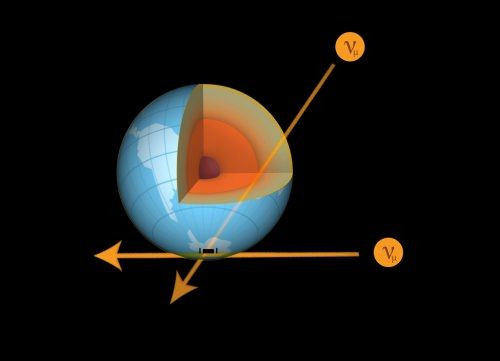Earth Can Block High-Energy Neutrinos, IceCube Observatory Experiment Finds
Neutrinos are nearly mass-less, charge-less particles that, on their paths through the vast expanse of space, pass through objects in their way. Given the particles’ general lack of interaction with matter, even as about 100 trillion of them pass through your body every second, you don’t feel a thing.
A much larger number passes through Earth each second, and neutrinos are thought to be the only particles that can travel through the planet. But a recently concluded experiment at the IceCube Observatory near the South Pole found high-energy neutrinos are, in fact, blocked or absorbed by Earth.
Insofar as elementary particles go, neutrinos are the most abundant matter particles in the known universe. They interact with other particles only through weak subatomic force and gravity, making their detection difficult. They exist in three different flavors, or types, though a fourth flavor — the sterile neutrino — is hypothesized and is a dark matter candidate.
The neutrinos passing through Earth and our bodies are low-energy, but their more energetic variants are the ones that were found to be blocked by Earth by IceCube. The observatory’s detector is made up of 5,160 basketball-sized sensors that are embedded in very clear ice, in a cubic kilometer of area one mile below the surface.

That high-energy neutrons should interact with other matter particles — neutrons and protons — had long been theorized but never observed before. The probability of that interaction is called the neutrino cross section, and it increases with increasing energy. IceCube data collected over a year showed the cross section for neutrino energies to be between 6.3 TeV and 980 TeV, which is several orders of magnitude higher than the 0.4 TeV energy among neutrinos generated and studied in particle colliders on Earth.
Gathered between May 2010 and May 2011, the data looked at almost 11,000 neutrino interactions. Specifically, it largely looked at neutrinos created by high-energy cosmic rays crashing into Earth’s atmosphere. It found fewer neutrinos than expected made their way from the northern hemisphere, through the planet’s dense core, to the observatory.

“This achievement is important because it shows, for the first time, that very-high-energy neutrinos can be absorbed by something — in this case, the Earth. We knew that lower-energy neutrinos pass through just about anything, but although we had expected higher-energy neutrinos to be different, no previous experiments had been able to demonstrate convincingly that higher-energy neutrinos could be stopped by anything,” Doug Cowen, a professor at Penn State University, which is a part of the IceCube collaboration, said in a statement Wednesday.
The study was led by researchers at the Department of Energy’s Lawrence Berkeley National Laboratory (Berkeley Lab) and University of California, Berkeley. Titled “Measurement of the multi-TeV neutrino interaction cross-section with IceCube using Earth absorption," it appeared online Wednesday in the journal Nature.
© Copyright IBTimes 2025. All rights reserved.





















